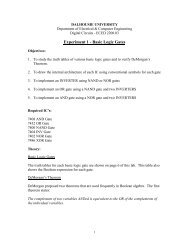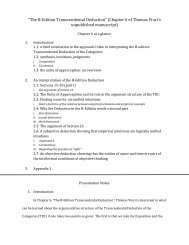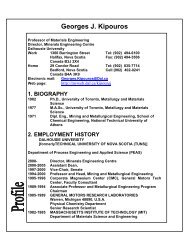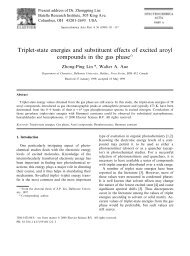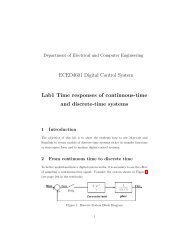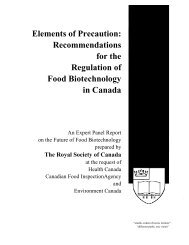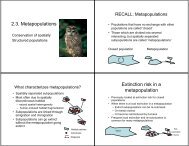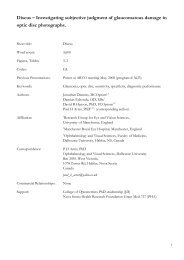Molecular Ecology Notes (2006) - Myweb.dal.ca - Dalhousie University
Molecular Ecology Notes (2006) - Myweb.dal.ca - Dalhousie University
Molecular Ecology Notes (2006) - Myweb.dal.ca - Dalhousie University
You also want an ePaper? Increase the reach of your titles
YUMPU automatically turns print PDFs into web optimized ePapers that Google loves.
PRIMER NOTE 925<br />
Table 1 Characterization of eight polymorphic microsatellite loci for white hake (Urophycics tenuis, Mitchill 1815): T a<br />
, annealing<br />
temperature (°C); number of alleles and (sample size, N), and allele size range; H O<br />
and H E<br />
, observed and expected heterozygosities,<br />
respectively; HWE within-samples (top) and overall (bottom) P values; and GenBank Accession nos<br />
T a<br />
Locus Primer sequence (5′−3′) Repeat motif allele (bp)<br />
Size of<br />
cloned<br />
No. of alleles/<br />
sample size<br />
(N)<br />
Allele<br />
size<br />
range H O<br />
H E<br />
HWE<br />
GenBank<br />
Accession<br />
no.<br />
Ute1 F: GGGGCGATTTAGACCAAAGT (GACA) 8<br />
54 157 7 (39) 148–172 0.8810 0.7768 0.98 DQ 294931<br />
R: GTGGGTCTGTCCAGGATGTT 0.99<br />
Ute12 F: CATCCTCTCCGAACACTGGT (CTGT) 13<br />
62 190 13 (44) 166–214 0.9070 0.8947 0.42 DQ 294932<br />
R: GCAGAAGCACCGGTTACATT 0.63<br />
Ute13 F: CCCTGCACTCCCTCCTCT (CTGT) 10<br />
65 128 10 (40) 126–170 0.8750 0.8509 0.80 DQ 294933<br />
R: AGAGGGCCGGGGCTATAT 0.55<br />
Ute19 F: GTCTGCCTGCCTGTCTAT (CTGT) 14<br />
54 182 7 (46) 156–180 0.7826 0.7413 0.67 DQ 294934<br />
R: GCAAAGGAAGAGAAGAAAAA 0.65<br />
Ute22 F: CTGTTTACCTCCGCTTTTAG (CTGT) 9<br />
60.5 264 24 (45) 222–362 0.8000 0.9039 0.001 DQ 294935<br />
R: ATCACTGCAAGAGACATGAT 0.001<br />
Ute27 F: TTTGTCGGTGCACTGTTACC (GACA) 12<br />
58 195 15 (42) 158–214 0.7674 0.8577 0.011 DQ 294936<br />
R: CCGGTTCTTCGTCTTTCCAC 0.017<br />
Ute34 F: ACTGACAGACGGGTCGATG (GACA) 11<br />
68 119 9 (45) 105–130 0.5435 0.6636 0.171 DQ 294937<br />
R: ACCTGAATGCTGCTGATGTG 0.054<br />
Ute35 F: CCCGAGGGTAACTCGATTG (GACA) 12<br />
GGCA(GACA) 7<br />
58 229 40 (47) 150–460 0.9783 0.9689 0.345 DQ 294938<br />
R: CGCTATTGGAGAGGTGAAGC 0.283<br />
amplifi<strong>ca</strong>tions of 10-µL volumes containing 0.5–1 µL of<br />
extracted DNA, 2.5 mm MgCl 2<br />
, 50 µm of each dNTP, 0.5 U<br />
Taq polymerase (Sigma), 1 µm of each primer (forward<br />
primers were 5′ end-labelled with IR700 or IR800 dye) and<br />
1× PCR buffer. PCRs included: 94 °C for 3 min, followed by<br />
30 cycles at 94 °C for 45 s, primer-specific T a<br />
(Table 1) for<br />
30 s and 72 °C for 30 s. Reactions were run in MJ Research<br />
thermocyclers and imaged on a LI-COR IR2 DNA Analyser<br />
model 4200.<br />
Gels were scored by eye and with saga automated<br />
microsatellite software (LI-COR). Tests for departure<br />
from Hardy–Weinberg equilibrium (HWE) and for linkage<br />
disequilibrium were conducted with fstat version 2.9.3.2<br />
(Goudet 1995). Observed and expected heterozygosities<br />
are reported (Table 1). There was no evidence for departures<br />
from HWE (either within samples or overall) for<br />
six out of the eight loci; the exceptions being loci Ute 22<br />
(P < 0.001) and Ute 34 (P < 0.011) (Table 1). No evidence<br />
of null alleles or large allele dropout was detected<br />
when the data were analysed using micro-checker<br />
(Goudet et al. 1995). Similarly, there was no evidence of<br />
genotypic disequilibrium between any pairs of loci<br />
even before correcting for multiple tests (P > 0.1046,<br />
α (95%)<br />
= 0.0017 with 28 pairwise comparisons). Preliminary<br />
(due to small sample size) tests for population differentiation<br />
(not assuming random mating within samples, i.e. loglikelihood<br />
G-test, Goudet et al. 1995) not surprisingly<br />
indi<strong>ca</strong>ted that, though markers may differ in their ability<br />
to discriminate among (these) populations (P ≤ 0.01 to<br />
P ≤ 0.82), this ability increases when all markers are<br />
considered jointly (P ≈ 0.002). Stronger tests of markers’<br />
ability for detecting population differentiation must,<br />
however, await the scoring of further samples of mature<br />
individuals in spawning condition. Primer sequences were<br />
deposited in GenBank [(Accession nos DQ 294931–DQ<br />
294938 (Table 1)]. Although no cross-species amplifi<strong>ca</strong>tion<br />
tests were conducted with these markers, markers<br />
developed for Atlantic cod, Gadus morhua (Gmo8, Gmo19,<br />
Gmo34, Gmo37, Miller et al. 2000; Gmo2 and Gmo132,<br />
Brooker et al. 1994), and for walleye Pollock, Theragra<br />
chalcogramma (Tch5, Tch11, Tch14, Tch22; O’Reilly et al.<br />
2000), were initially tested on our samples of white hake<br />
but failed to amplify successfully.<br />
Acknowledgements<br />
Funding to DER for this research was provided by the Canadian<br />
Department of Fisheries and Oceans (DFO). The valuable advice of<br />
Ian Paterson and Friso Palstra (Gene probe Laboratory, <strong>Dalhousie</strong><br />
<strong>University</strong>) and the collection of samples by Alida Bundy, Tom<br />
Hurlbut and Dave Kulka (DFO) are gratefully acknowledged.<br />
References<br />
Brooker AL, Cook D, Bentzen P, Wright JM, Doyle RW (1994)<br />
Organization of microsatellites differs between mammals and<br />
cold-water teleost fishes. Canadian Journal of Fisheries and Aquatic<br />
Sciences, 51, 1959–1966.<br />
Diniz FM, MacLean N, Paterson IG, Bentzen P (2004) Polymorphic<br />
tetranucleotide microsatellite markers in the Caribbean spiny<br />
lobster, Panulirus argus. <strong>Molecular</strong> <strong>Ecology</strong> <strong>Notes</strong>, 4, 327–329.<br />
Goudet J (1995) fstat (version 1.2): a computer program to<br />
<strong>ca</strong>lculate F-statistics. Journal of Heredity, 86, 485–486. Software<br />
available at www2.unil.ch/popgen/softwares/fstat.htm.<br />
© <strong>2006</strong> The Authors<br />
Journal Compilation © <strong>2006</strong> Blackwell Publishing Ltd



